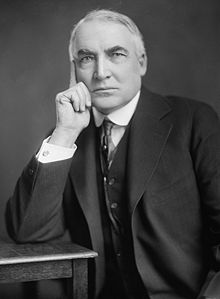Warren G. Harding | |
|---|---|
 Portrait, c. 1920 | |
| 29th President of the United States | |
| In office March 4, 1921 – August 2, 1923 | |
| Vice President | Calvin Coolidge |
| Preceded by | Woodrow Wilson |
| Succeeded by | Calvin Coolidge |
| United States Senator from Ohio | |
| In office March 4, 1915 – January 13, 1921 | |
| Preceded by | Theodore E. Burton |
| Succeeded by | Frank B. Willis |
| 28th Lieutenant Governor of Ohio | |
| In office January 11, 1904 – January 8, 1906 | |
| Governor | Myron T. Herrick |
| Preceded by | Harry L. Gordon |
| Succeeded by | Andrew L. Harris |
| Member of the Ohio Senate from the 13th district | |
| In office January 1, 1900 – January 4, 1904 | |
| Preceded by | Henry May |
| Succeeded by | Samuel H. West |
| Personal details | |
| Born | Warren Gamaliel Harding November 2, 1865 Blooming Grove, Ohio, U.S. |
| Died | August 2, 1923 (aged 57) San Francisco, California, U.S. |
| Resting place | Harding Tomb |
| Political party | Republican |
| Spouse | |
| Children | Elizabeth (with Nan Britton) |
| Parent |
|
| Education | Ohio Central College (BA) |
| Occupation |
|
| Signature | |
| ||
|---|---|---|
|
Political rise
29th President of the United States
Presidential campaigns
Controversies
 |
||
Warren Gamaliel Harding (November 2, 1865 – August 2, 1923) was the 29th president of the United States, serving from 1921 until his death in 1923. A member of the Republican Party, he was one of the most popular sitting U.S. presidents while in office. After his death, a number of scandals were exposed, including Teapot Dome, as well as an extramarital affair with Nan Britton, which tarnished his reputation.
Harding lived in rural Ohio all his life, except when political service took him elsewhere. As a young man, he bought The Marion Star and built it into a successful newspaper. Harding served in the Ohio State Senate from 1900 to 1904, and was lieutenant governor for two years. He was defeated for governor in 1910, but was elected to the United States Senate in 1914—the state's first direct election for that office. Harding ran for the Republican nomination for president in 1920, but was considered a long shot before the convention. When the leading candidates could not garner a majority, and the convention deadlocked, support for Harding increased, and he was nominated on the tenth ballot. He conducted a front porch campaign, remaining mostly in Marion and allowing people to come to him. He promised a return to normalcy of the pre–World War I period, and defeated Democratic nominee James M. Cox in a landslide to become the first sitting senator elected president.
Harding appointed a number of respected figures to his cabinet, including Andrew Mellon at Treasury, Herbert Hoover at Commerce, and Charles Evans Hughes at the State Department. A major foreign policy achievement came with the Washington Naval Conference of 1921–1922, in which the world's major naval powers agreed on a naval limitations program that lasted a decade. Harding released political prisoners who had been arrested for their opposition to World War I. In 1923, Harding died of a heart attack in San Francisco while on a western tour, and was succeeded by Vice President Calvin Coolidge.
Harding died as one of the most popular presidents in history. The subsequent exposure of scandals eroded his popular regard, as did revelations of extramarital affairs. Harding's interior secretary, Albert B. Fall, and his attorney general, Harry Daugherty, were each later tried for corruption in office; Fall was convicted while Daugherty was not, and these trials greatly damaged Harding's posthumous reputation. In historical rankings of U.S. presidents during the decades after his term in office, Harding was often rated among the worst. In the subsequent decades, some historians have begun to reassess the conventional views of Harding's historical record in office.
